|
|
Volume 7 Number 3, Third Quarter 1995

Frank Marshall,Vice President and General Manager, Cisco's Core Products Business Unit
Fast-evolving networking technologies and user applications present a challenge to network planners: will their existing networks -- which they've spent years building -- continue to meet the growing needs of the user community? Today's changing business climate and the computer applications required for success seem to call for continuous, enterprise-wide network expansion. In light of our rapidly changing environment, this quarter's Packet magazine asks "Are you set for the future?"
At Cisco Systems, we continuously strive to find practical ways to address the future by bringing emerging technologies to the market on existing platforms as well as employing new delivery vehicles. Our goal is to preserve our customers' investments -- without compromising the benefits of new technology.
This month we're announcing the Cisco 7500 core router, which builds on the high performance of our flagship Cisco 7000 series. The best of the breed just got better. The new Cisco 7500 line brings greater interface densities, more card slots, higher performance, and increased router availability features. The Cisco 7500's design allows users to move their existing interface cards between the Cisco 7000 and Cisco 7500 platforms. Interface cards for the Cisco 7000 are forward-compatible, so users can redeploy existing I/O capabilities to the Cisco 7500 to gain its higher aggregate performance. Our announcement includes a new Versatile Interface Processor (VIP) card, which enables very high port density and the use of mixed-media interfaces. Users can also install these VIP I/O systems in their existing Cisco 7000 systems.
To ensure that our customers continue to receive returns on their investments in the Cisco 7000, Cisco has created an Investment Protection Program. Targeting customers who have both Cisco 7000 and Cisco 7500 installations, this program assures that they receive the right products to maintain cross-platform compatibility. The Investment Protection Program is described in "New Cisco 7500 Delivers More Routing Muscle."
Our new interfaces for the Cisco 4000 series of midrange routers are another example of how we help customers maximize the value of their network equipment. These new interfaces allow organizations that have invested in the Cisco 4000 platform to expand its capabilities. We've increased port densities and introduced new media support to make these compact routers scale in proportion to our customers' growing businesses. Again we've focused on forward and backward compatibility to enhance the value of users' existing installations.
Customer investment in Cisco products is further enhanced by the Cisco Internetwork Operating System (Cisco IOS[tm]) software. Each major release contains new features that add capabilities to existing platforms. For example, organizations with plans to support multimedia applications, such as desktop videoconferencing or real-time information kiosks, must reconfigure their networks to support these applications. Often this process can take place initially in software instead of requiring new hardware. The Cisco IOS software offers many features that support multipoint, delay- sensitive applications while preserving today's existing network infrastructures. In "RSVP for the Multimedia Party," look for an overview of the new Resource Reservation Protocol (RSVP), which allows applications to tell the network of their transmission needs to guarantee effective delivery. RSVP provides consistent service levels across multimedia networks, minimizing the need for added bandwidth. As part of the Cisco IOS software, RSVP will be available on Cisco routers.
Through these new products and others, Cisco demonstrates its commitment to making products that endure. So, are you set for the future? Our goal at Cisco is to make sure your answer is a resounding yes.

Frank Marshall
Vice President and General Manager
Cisco's Core Products Business Unit
___________________________________________________________________________________________________________
Businesses need a networking strategy that meets their continuously growing requirements without obsoleting their investments in network technology. The newest member of the Cisco 7000 multiprotocol router family, the Cisco 7500, delivers performance and functionality to address today's high-bandwidth applications while protecting existing hardware and software investments.
The Cisco 7500 series routers bring new levels of performance, availability, and port density to support the routing requirements of fast-growing internetworks.
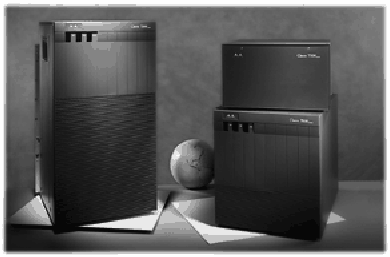
It's no news to network managers that the greatest challenge they face today is keeping up with users' insatiable appetite for increased bandwidth. Virtually every trend on the business landscape today -- client/server computing, multimedia, collaborative computing, or telecommuting -- drives the demand for higher performance within an enterprise network. And there's no end in sight.
The expanding requirements for high-performance routers appear in several environments. In LANs, routing performance is fundamental for scalable ATM networks, multilayer LAN switching, and virtual LAN technologies. In WAN environments, the spread of higher-speed frame and ATM services requires corresponding router performance. In addition, routers are increasingly performing value-add functions, such as encryption and communications processor offload, which demand more routing power.
"The Cisco 7500 gives network managers routing capabilities that are essential for building huge, scalable internetworks," says Richard Palmer, Cisco's Director of Marketing for Core Products. "It delivers those capabilities faster and more reliably than any other high-end router on the market, while preserving the investments our users have made in the Cisco 7000 series."
The Cisco 7500 significantly extends the capabilities of the Cisco 7000 series routers. This new series increases port densities per chassis and brings higher performance and high-availability features, such as dual system processors and dual high-speed buses. In conjunction with the Cisco Internetwork Operating System (Cisco IOS[tm]) software, the Cisco 7500 series gives users unparalleled control over the operation of their networks. Companies can optimize bandwidth utilization, assign priority to specific applications, and guarantee quality of service. These features, combined with the ability to support multipoint packet delivery, make the new routers well suited to multimedia networking.
The Cisco 7500 extends the Cisco 7000 platform, enabling customers to use their existing interface processors on both the Cisco 7000 and 7500 series. Interface processors are forward-compatible, so customers can redeploy them to the Cisco 7500 to gain its higher aggregate route/switch processing performance. At the same time, users can install a newly introduced processor card -- the Versatile Interface Processor (VIP) -- in their existing Cisco 7000 systems to take advantage of the higher densities and mixed-media configurations that this card supports.
"Between 60 and 80 percent of a company's investment in Cisco 7000 networking equipment today is in interface cards," states Dale Boehm, Cisco 7000 Product Line Manager. "As we designed the Cisco 7500, we focused on protecting that investment for our customers."
While all interface cards are forward compatible, some call for upgrades before use in the Cisco 7500 system. For SMARTnet[tm] customers, Cisco's new Investment Protection Program (IPP) provides no-cost upgrades as needed for interface cards shipped before January 1, 1995.
In addition to ensuring forward compatibility for interface cards through the IPP program, Cisco offers a system upgrade program to help customers with AGS+ routers to migrate to Cisco 7000 and 7500 routers. The program allows customers to exchange their AGS+ systems for credit to apply toward the purchase of any Cisco 7000 or 7500 router. The program's financial incentives and flexibility pave the way for customers to evolve their networks for new requirements.
"The Cisco 7500 series delivers dramatically increased system performance, much higher port densities, and greater system availability," comments Boehm. Specifically, in comparison with the current capabilities of the Cisco 7000 series, the Cisco 7500 quadruples bandwidth capacity, increases maximum port density by 100 percent, and provides redundancy for route/switch processing. This expansion of capabilities is provided by the Cisco 7500's distributed multiprocessor architecture, which consists of the high-speed CyBus, Route/Switch Processors (RSPs), and the Versatile Interface Processor (VIP).
The Cisco 7500 series includes three new models, with 5, 7, or 13 chassis slots. All accommodate the full range of interface processors already supported by the Cisco 7000 series: Ethernet, Token Ring, Fast Ethernet, Fiber Distributed Data Interface (FDDI), serial, High-Speed Serial Interface (HSSI), Asynchronous Transfer Mode (ATM), channelized T1/E1, and IBM channel attachment.
A new multiprocessor architecture enables the Cisco 7500 to quadruple bandwidth capacity of the Cisco 7000 and increase maximum port density by 100 percent while providing redundancy for route/switch processing.
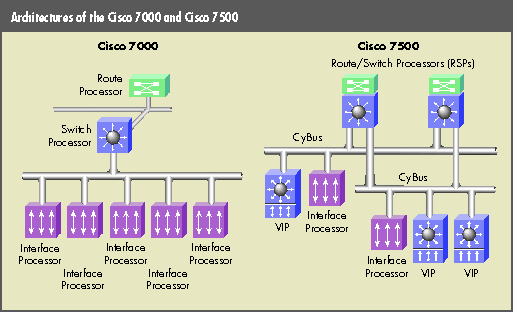
The high-speed CyBus, available in single- and dual-bus configurations, is designed to support high-speed LANs and WANs and to increase system availability for all applications. Each CyBus provides a full gigabit of data bandwidth, delivering a total system performance of two gigabits in the dual-bus models -- four times the capacity of the Cisco 7000 CxBus.
The new Route/Switch Processor (RSP) enables high aggregate performance and system availability. Based on a high-performance RISC engine, the RSP integrates route and switch processing on a single card -- replacing two cards on a Cisco 7000. As with the Cisco 7000, the two functions operate independently to ensure that both are fully optimized: route calculation for stability and security, and high-performance multilayer switching for scalable performance.
The integrated RSP can make switching information available to the VIP card, allowing switching responsibilities to be distributed among interface cards. Network scalability is enhanced, because switching functionality is distributed throughout the system. In the dual-RSP configuration, system availability is increased through master/slave mode operation. If the master RSP fails, the slave RSP takes control of the system without operator intervention.
Cisco's new VIP technology is the key to supporting bandwidth-hungry applications like multimedia and videoconferencing by boosting aggregate system performance to over one million packets per second. The VIP's RISC- based processor receives and caches routing information from the route server in the RSP. Using this data, it can make switching decisions locally, speeding throughput.
The VIP's modular port adapters enable flexible configurations and easy support for mixed LAN media. Each VIP provides slots for two adapters that can support multiple interface types. Initial configurations will provide Ethernet, Fast Ethernet, and serial connections. During 1996, additional port adapters will be introduced, providing increased density and capabilities such as encryption and compression.
| Solutions for High-Performance Applications |
|---|
| The Cisco 7500 is an excellent routing solution for enterprises requiring extremely high performance and system availability. Financial Institutions -- Network performance is critical to banks that process millions of electronic transactions daily. By using the Cisco 7500 to offload processing, such as SDLC-to-LLC2 conversion, from their IBM mainframes, banks can improve their overall mainframe performance. Dual RSPs provide high reliability for these mission-critical applications. Retail -- Large retailers rely on their point-of-sale systems to manage inventories and record transactions across their operations. Retailers can reduce WAN costs significantly with support for high-speed compression, ISDN, and other protocols and features of the Cisco IOS software. In addition, the Cisco 7500, with its significantly increased port density, reduces costs at each location. Internet Service Providers -- Operating in one of today's fastest growing businesses, Internet service providers face the challenges of a constantly expanding user base, increasing traffic, and support for a growing number of multimedia applications. The increased port density of the Cisco 7500 enables Internet service providers to support more customers on a router, while the Cisco 7500's scalability makes it easy to handle rapidly increasing traffic. The online insertion and removal capabilities of the Cisco 7500 series eliminate maintenance downtime and increase system availability. |
A financial institution can use the Cisco 7500 to lighten its mainframe's processing load, thus improving overall performance across the network.
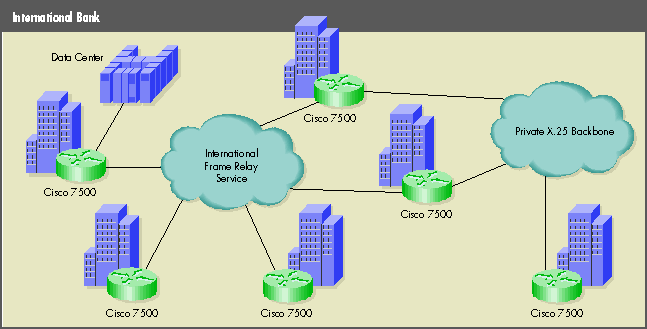
With its increased availability features and higher port density, a Cisco 7500 equipped with a Channel Interface Processor (CIP) card and the potent Cisco IOS software makes an excellent data center integration platform. By supporting a wide range of LAN and WAN interfaces -- including the CIP, which is Cisco's enhanced IBM mainframe channel-attachment solution -- the Cisco 7500 can strategically consolidate data center communications.
"With its distributed switching functions," says Palmer, "the Cisco 7500 can be described as `the CiscoFusion[tm] architecture in a single box." The CiscoFusion concept maps out a path for migrating routed internetworks toward a switched networking environment. The Cisco 7500 implements this design. Its sophisticated Route Processor distributes network information to one or more Switch Processors. These can be located on the same card, on interface cards in the router chassis, or on a standalone switch like the Cisco Catalyst[tm] 5000 that incorporates multilayer functionality.
Combining the advantages of today's routed internetworks with ATM, multilayer switching, and virtual LAN technologies, the CiscoFusion model enables organizations to build large networks powerful enough to support emerging high-bandwidth applications and flexible enough to support a wide variety of user needs.
___________________________________________________________________________________________________________
ATM, ISDN PRI, Six-Port Ethernet, and G.703 Cards Now Shipping
Cisco has launched an array of new interface modules for the Cisco 4000 series to reinforce the value of this midrange router product line, which includes the Cisco 4000 and Cisco 4500. The new modules introduce solutions for Asynchronous Transfer Mode (ATM), Integrated Systems Digital Network (ISDN) Primary Rate Interface (PRI), high-density Ethernet, and G.703 serial connections. These interface modules extend the value of installed Cisco 4000 series routers significantly by providing cost savings and increased bandwidth, whether organizations use their routers as remote nodes in branch offices or as backbone devices at headquarters offices.
New processor modules for the Cisco 4000 router series enable a wealth of new applications over LANs and WANs.
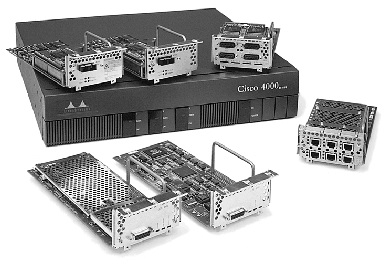
The new ATM network processor module for the Cisco 4500 provides a high- performance, low-cost ATM access solution. Used with Cisco's LightStream[tm] ATM switches, workgroup switches, ATM network adapters, and high-performance routers, the ATM interface for the Cisco 4500 makes Cisco's product offerings for ATM the most comprehensive solution on the market today.
Cisco's new ATM network processor module, operating at OC-3 STS-3/STM-1 (155 megabits per second, or Mbps), performs both single-mode and multimode data transmission. With support for native ATM cell processing, the card eliminates the need for an external ATM DSU. As part of the CiscoFusion[tm] architecture and leveraging the Cisco Internetwork Operating System (Cisco IOS[tm]) software, the card supports Multiprotocol Encapsulation over ATM as well as Classical IP and ARP over ATM (RFCs 1483 and 1577). In late 1995, the module will support the ATM Forum's LAN Emulation (LANE) standard, which allows higher-layer protocols to run unmodified over ATM, enabling the creation of virtual LANs (VLANs).
The ATM network processor module connects to ATM networks from Ethernet or Token Ring segments, for example, providing cost-effective access for high- bandwidth applications over LANs. The Cisco 4500 can support as many as 12 Ethernets, 4 Token Rings, or 1 Fiber Distributed Data Interface (FDDI) segment connected to an ATM network.
Equipped with an ATM network processor module, the Cisco 4500 router can connect directly to a Cisco LightStream[tm] ATM switch, providing building or campus backbone access at data rates of up to 155 Mbps.
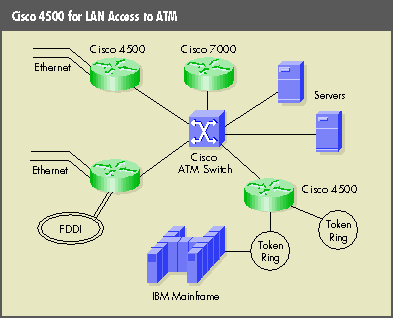
The ATM network processor module can connect different sites across an ATM WAN or provide a low-cost method of ATM access for traditional low-speed WAN services. Some customers are building private ATM WANs because they need to transport large volumes of diverse traffic types between distant sites. The new ATM module for the Cisco 4500 provides an economical way to transport LAN traffic over these private ATM WANs. With Cisco 4500 support for traditional serial interfaces, the ATM module can be used to connect ATM workgroup and enterprise switches to lower-speed WAN services.
With the channelized E1/T1 network processor module for the Cisco 4000 router series, network managers can consolidate a number of remote serial links through a single interface on a central router.
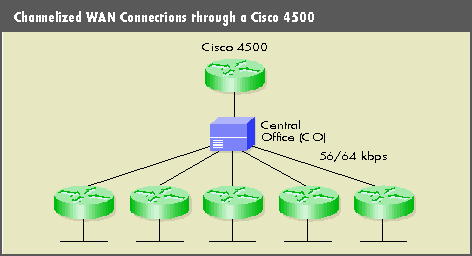
Two single-port ISDN PRI interfaces are now available for the Cisco 4000 and 4500 modular routers. One of the cards, designed for use in North and South America and Japan, supports up to 23 64-kilobits-per-second (kbps) ISDN bearer (B) channels for data transmission; the other card, for use in Europe and Australia, supports up to 30 64-kbps ISDN B channels. These cards also support channelized T1 and E1 services where offered by carriers.
The new ISDN PRI interfaces join existing Cisco ISDN products -- from software-based ISDN router cards for PCs and standalone, entry-level routers with single ISDN Basic Rate Interface (BRI) ports, to multiport BRI cards for the Cisco 4000 family and PRI cards for the Cisco 7000 family of core routers -- to provide the industry's most comprehensive ISDN solution set.
"ISDN PRI brings higher-density, more cost-effective ISDN connectivity to the Cisco 4000 line than was possible with BRI interfaces," says Kevin Kennedy, Cisco Director of Marketing for Remote Access Products. With two PRI cards installed, a Cisco 4500 in conjunction with remote-site Cisco 1003 or Cisco 2500 ISDN routers can support up to 60 LANs or individual remote users dialing in simultaneously to a major site.
The E1-speed PRI network processor module provides support for Channelized E1 and PRI services throughout Europe and Australia. Using the Cisco 4500, users can configure densities of up to 60 64-kbps ISDN B channels, yielding very cost-effective ISDN PRI solutions. Correspondingly, the T1 module provides support for Channelized T1 and PRI services throughout the US and Japan. With the Cisco 4500, users can support densities of up to 46 64-kbps ISDN B channels.
The E1/T1 network processor modules can be used for channelized E1 or T1 WAN services in areas where support for these services is available. Used at the head end of a WAN topology, these modules can aggregate a number of 56- or 64-kbps lines into a single channelized E1 or T1 line. For example, an organization can have 30 different WAN links connecting into a single E1 module on a Cisco 4000 router at headquarters. Likewise, a T1 module could support 24 serial connections through a single port. In terms of WAN tariffs, this configuration tends to be less expensive than having the same number of separate serial interfaces into a router. Furthermore, the E1/T1 network processor modules solve the problem of port density required to support an equal number of separate serial ports on a single router. Typically, to attain the same number of connections offered by Cisco's PRI module running channelized E1 or T1, a user would need a high-end core router. The consolidated interface provided through channelization on the Cisco 4000 series also simplifies management tasks by reducing the amount of hardware required.
The E1 and T1 PRI modules support incoming calls from remote routers and LANs as well as from ISDN remote nodes. The existing four- and eight-port ISDN multiple BRI cards for the Cisco 4500, as well as the new ISDN PRI modules, support remote nodes that run synchronous Point-to-Point Protocol (PPP).
The ISDN PRI software associated with these new products is compatible with existing BRI/PRI software found on the Cisco 2500, Cisco 4000, and Cisco 7000 series routers. To ensure access to the full set of ISDN software features, existing ISDN routers should be upgraded to the latest Cisco IOS version.
ISDN PRI products require homologation in most areas of the world where ISDN is available from local carriers. Requirements for certification to public network services vary from country to country and from service to service, which may affect the availability of these products in some areas. Cisco records its updated ISDN approvals status on its Cisco Connection Online (CCO) service. Registered CCO users can access this information using the following path: from the CCO main menu, select Product Information, then select Product Approval Status by Country.
The E1 PRI module has Pan-European homologation approvals, because Cisco is certified against the I-CTR4 Euro-ISDN specification. Cisco also supports PRI signaling for the older French national systems. Complete telecom network certification information, including country-by-country status, is available on CCO.
The new PRI modules, available immediately, require Cisco IOS Release 10.3(4) or later. The Cisco 4000 and Cisco 4000-M can each support a single PRI module, while the Cisco 4500 and Cisco 4500-M support a maximum of two PRI modules each.
Cisco Systems' new six-port Ethernet Network Processor Module for the Cisco 4500 provides six 10BaseT ports, tripling the density of the existing Ethernet options for this router platform. With three six-port modules installed, the Cisco 4500 can connect up to 18 Ethernet segments. Alternatively, two Ethernet modules and an ATM or FDDI interface provide economical access for 12 Ethernets to an ATM or FDDI backbone. The use of Cisco's Hot Standby Router Protocol (HSRP) with dual Cisco 4500s allows users to build highly fault-tolerant networks for applications that require maximum applications availability. For more information on HSRP, see "Some Like It Hot," Packet, Second Quarter 1995 (Vol. 7, No. 2).
Many organizations seek a way to connect Ethernet workgroups or segments to FDDI backbones or to migrate their backbones from FDDI to ATM -- while retaining the protocol breadth, support, and control of routers. Using the Cisco 4500 with the new ATM and six-port Ethernet interfaces together, these organizations can connect up to 12 Ethernet segments to an ATM switch or FDDI backbone. The Cisco IOS software provides the intelligence needed for capabilities such as firewalls, routing policies and other traffic-handling techniques.
The six-port Ethernet module, combined with Ethernet workgroup switches, provides a high-performance, low-latency method of bridging or routing between switch segments. For example, used with Cisco's ProStack system, the Cisco 4500 can offer very low-cost, high-bandwidth solutions with maximum control from the Cisco IOS software.
Available now, the six-port Ethernet module requires Cisco IOS Release 10.3(5), 11.0, or higher. A Cisco 4500 router supports three of these modules.
To address the needs of telecommunications carriers in Australia and Europe, Cisco has introduced a G.703 network processor module for the Cisco 4000 and Cisco 4500 routers. This module provides four serial ports for G.703 WAN lines.
The G.703 physical/electrical interface specification is used for leased lines running bidirectionally at 2 Mbps. Popular among service providers in certain European countries and Australia, G.703 is typically used for WAN services between regional sites or between regional sites and headquarters.
Now shipping, the G.703 network processor module requires Cisco IOS Release 10.2(7) or higher. Each Cisco 4000 or Cisco 4500 supports a maximum of three of these modules.
The new interface options for the Cisco 4000 series routers enrich the value of this platform, especially for Cisco customers who have already purchased Cisco 4000s or Cisco 4500s. Today, this product family is more scalable than ever, allowing growing organizations to make the most of it even as their networking requirements evolve to support more users and sophisticated applications. Incorporation into the CiscoFusion architecture and the ability to support high densities of LAN and remote connections place this compact, midrange product family among the industry's most flexible and versatile solutions available.
___________________________________________________________________________________________________________
Cisco and the Resource Reservation Protocol Help Routers with Applications of the Future
With the promise of exciting, bandwidth-demanding multimedia applications of the future, network managers must begin planning ways to support voice, video, and images across their internetworks. Implementation of these new applications, as well as traditional mission-critical data applications, calls for guarantees of consistent quality of service. And while these new applications require a fundamentally different approach to routing and network resource allocation, they -- like the mechanisms for handling them -- must also fit with the router-based networks of today.
To meet these requirements, the Internet Engineering Task Force (IETF), a voluntary association charged with creating new Internet technology standards, is defining the Resource Reservation Protocol (RSVP), an end-to- end internetworking protocol compatible with current Transmission Control Protocol/Internet Protocol (TCP/IP) networks. Now an IETF Proposed Standard, RSVP will be supported in an upcoming release of the Cisco Internetwork Operating System (Cisco IOS[tm]) software targeted for delivery in the first quarter of 1996.
RSVP is an outgrowth of the IETF's work on integrated services, which provide a means for networks to support special qualities of service for applications that need them while preserving current internetworking methods. This protection of users' existing network infrastructures is fundamental to RSVP.
RSVP works very well in tandem with a traffic management algorithm fresh out of the research community -- Weighted Fair Queuing. For more information on this algorithm, see the table below.
| Weighted Fair Queuing |
|---|
| To cope with the wildly varying kinds of traffic that traverse multimedia networks, Cisco will support Weighted Fair Queuing. In Cisco IOS Release 11.0, this capability is used to dynamically prioritize traffic so that transaction applications experience low delay and bulk transfers are predictable. Coupled with RSVP, Weighted Fair Queuing guarantees individual data flows the bandwidth and delay characteristics that they negotiate. Weighted refers to the fact that individual data streams are isolated and given a percentage of the bandwidth on a link, and that this percentage can be varied by applying "weights" derived from RSVP's reservations. Fairness in Weighted Fair Queuing means that low-volume applications, such as interactive or transaction protocols, always experience low delay and always get priority service, and high-volume applications get equal bandwidth and predictable queuing delays. With Weighted Fair Queuing, interactive applications are not pushed out of the way by other applications that require bulk transfers, and high-volume applications are guaranteed to be transmitted (possibly with some delay), even if they are in competition with other similar capacity-demanding applications. Weighted Fair Queuing causes interactive round-trip delays to become predictable, because traffic flows are smoothed out as delay is redistributed away from low-volume applications. And coincidentally, round trips can take an order of magnitude less time than they would have taken without the addition of Weighted Fair Queuing -- a result of network capacity being better utilized. In addition to making multimedia applications practicable over existing router-based internetworks, Weighted Fair Queuing can moderate the demand for ever-increasing amounts of network bandwidth. This aspect should offer some relief to network managers, who often feel that they must upgrade their facilities when their networks reach saturation during peak periods or when users complain of unpredictability, lost sessions, or high transaction delays. But Weighted Fair Queuing, while creating predictability and reducing interactive round-trip delay, can enable lines to be used at much higher traffic densities. This ability, in turn, allows network managers to add bandwidth in a measured fashion, providing the margin to create balanced and well-thought-out upgrade paths. And with Weighted Fair Queuing, they can further leverage their network investments without fear of underserving their user communities. Weighted Fair Queuing thus will not only support multimedia applications, but will also help exploit existing networks for their full bandwidth potential. To create a smooth upgrade path, Weighted Fair Queuing is compatible with Asynchronous Transfer Mode (ATM) to meet the needs of next-generation networks. |
Traditional network functions, such as file transfers, are not sensitive to delay. While network users may prefer that a file transfer occur quickly, the transfer will take place regardless of the amount of time it takes. Traffic generated by these applications is called elastic, because it can stretch to work under any delay conditions.
But new multimedia network applications, such as voice and video, require that certain minimum numbers of bits be transferred within a specific timeframe or they lose all coherence. To arrive successfully, the inelastic traffic generated by these applications requires the network to allocate specific resources for it.
The mission of RSVP is to allow routers to communicate among themselves and with end systems so that they can reserve end-to-end network resources for inelastic applications.
What Is Quality of Service? Every network application has a basic set of requirements that the network must meet to deliver the traffic generated by this application in a usable form. These conditions, which center on bandwidth and delay characteristics, are described as quality of service requirements.
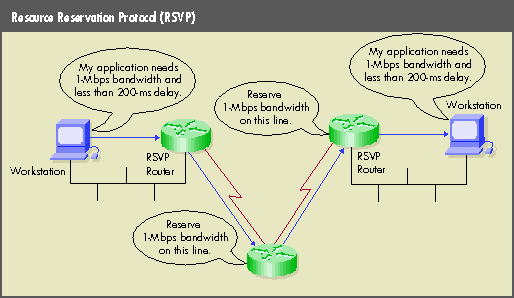
In an RSVP environment, applications that receive inelastic traffic inform networks of their needs, while applications that send inelastic traffic inform these receivers about the traffic characteristics that they may specify. This user-transparent process gives RSVP network entities the information they need to reserve the required amounts of bandwidth throughout an entire network.
RSVP is a receiver-based protocol, which means that it treats networks much as cable television does: the selectivity is in the receiving application, much as a cable TV viewer might tune in to a specific channel. The router that is connected to the receiver of a particular data flow (for example, the transmission of a video file) is responsible for initiating and maintaining the resources used for that data flow.
RSVP receivers periodically alert networks to their interest in a data flow, using messages that contain the source IP address of the requester and the destination IP address, usually coupled with flow details. With the information received from these messages, the network can allocate the needed bandwidth and define priorities.
Once interest in a data flow is past (for example, upon completion of a video transfer), an RSVP receiver can simply stop advertising its interest in the flow, or, at a more active level of participation, it can advertise a decision to stop receiving all flows.
An RSVP sender uses another type of message to announce itself, exchange address information, and give RSVP receivers the information they need to create their outgoing messages.
A unique RSVP feature, soft-state, allows networks to be self-correcting despite routing changes and loss of service. The mesh of soft-state with messages from RSVP senders and receivers within an internetwork enables routers to understand not only their current topologies and interfaces, but the amount of current network bandwidth supported. RSVP-equipped routers can adjust network capacity in real time, providing variable quality of service.
With RSVP and Weighted Fair Queuing, the Cisco IOS[tm] software provides support for multimedia applications while protecting users' network investments. Cisco and its partners are committed to making voice, video, and imaging applications -- and their associated resource requirements -- work well and affordably in today's networks and tomorrow's.
___________________________________________________________________________________________________________
___________________________________________________________________________________________________________
Cisco Systems has mapped out a comprehensive strategy for effective management of IBM routed internetworks, with the first component already shipping. Cisco's IBM internetwork management program, known as CiscoWorks[tm] Blue, will be implemented as a series of new capabilities starting with Native Service Point support, which will give IBM host operators full visibility into and control over Cisco routers.
Subsequent elements of the CiscoWorks[tm] Blue program will provide for management of SNA routed internetworks using the CiscoWorks suite of management applications; mapping of IBM-related protocols; improved detection of congestion-related problems; and configuration, design, and simulation of SNA internetworks.
"We spent considerable time working with our IBM-oriented customers to understand their management needs," says Nick Francis, Director of Marketing for Cisco's business unit for IBM internetworking. "The set of strategic offerings that we came up with addresses those needs."
With Cisco Native Service Point support, IBM host operators will be able to monitor and control the routed portions of their internetworks for the first time, bringing to client/server environments the level of manageability these users have come to expect. Designed for SNA customers who have invested substantially in IBM's NetView or Sterling Software's NetMaster, Native Service Point reduces the need to buy the PC- or UNIX-based network management systems that are commonly used in routed internetworks.
From an IBM NetView operator console, a user can issue any command that normally would be entered at the router console, obtaining router status, monitoring traffic on specific interfaces, and invoking debugging commands to pinpoint problems. Cisco routers, previously manageable only by a Simple Network Management Protocol (SNMP)-based manager, appear to the virtual telecommunications access method (VTAM) operator as PU 2 devices, forwarding alerts directly to NetView. Routers respond to RUN commands in the form of NetView network management vector transports (NMVTs), which are generated in the powerful Cisco Internetwork Operating System (Cisco IOS[tm]) software.
Password access ensures that only designated individuals can issue certain commands, and further security is provided by a status-checking mechanism that reveals which operators are monitoring specific routers.
For internetworks that use both IP and SNA, the CiscoWorks Blue Maps facility will enable the management of these entire internetworks from a single CiscoWorks console. Toward this end, Cisco will introduce a broad array of SNA-related Management Information Base (MIB) variables and a set of applications designed to exploit those MIBs to create and display logical topology maps.
CiscoWorks Blue Maps displays SNA and IP resources on the same management screen, allowing navigation between views. This capability helps network managers to determine, for example, if an IP internetworking issue is related to a higher-layer SNA problem. The user also can choose to view a region of a network or a specific path. For example, a remote source-route bridging (RSRB) map provides detailed data on traffic, peer status, etc., for RSRB traffic only. CiscoWorks also can interrogate the SNA MIBs to provide information to the CiscoView[tm] application, which depicts physical views of Cisco devices.
A remote source-route bridging (RSRB) map can provide detailed data on traffic, peer status, etc., for RSRB traffic only.
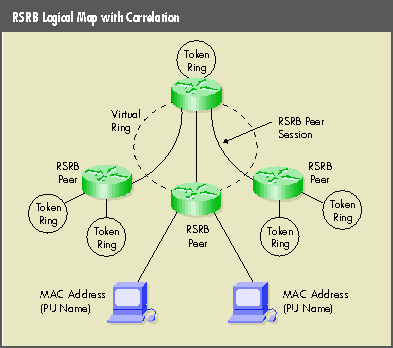
A major unaddressed need in SNA networks is the ability to know which router port connects a specific SNA resource. In first quarter 1996, Cisco will provide a new CiscoWorks application that maps SNA physical and logical units (PUs and LUs) to actual router ports.
An on-screen display showing connections between SNA devices and routers will eliminate the manual investigation needed today to determine which router and routed path are associated with an SNA-related problem. This new capability will greatly speed problem resolution.
Today's performance tools typically give users only one measure of response time -- from end station to host. Truly effective problem resolution requires the ability to capture response time at each "hop" along the path. Cisco's Response Time Reporter, which examines every link in the network using CiscoWorks-configurable router-based agents, show users precisely where the congestion is and whether the problem lies in the SNA or the IP environment. Planned for a 1996 release of Cisco IOS software, this application will significantly improve the operator's ability to detect problems associated with traffic delays.
Cisco will provide tools, based on technology licensed in January 1995 from NETSYS Technologies Inc., that enable the problem solving, modeling, and design of routed networks in IBM environments. In the fourth quarter of 1995, the NETSYS Connectivity Tools will be adapted to the IBM AIX RS/6000 platform, creating a simulation environment that network planners can use to study the potential impact of failed links, configuration changes, and other factors on their networks. Long-term plans call for the extension of these tools to include in-depth "what-if" analyses and the ability to examine a drawn network and automatically generate the configuration files that today's users must create manually.
Since the early 1990s, when Cisco launched its five-phase strategy for IBM internetworking, the company has invested heavily in determining the needs of network managers in IBM environments and then meeting those needs. Cisco has now delivered all phases of that strategy and will continue to enhance tools for the design and management of integrated IBM internetworks.
___________________________________________________________________________________________________________
Cisco Systems has introduced a single product that combines access router and wiring hub functions, reducing the cost and complexity of connecting small-office Token Ring LANs across wide-area links to enterprise internetworks or the Internet.
The new Cisco 2517 Token Ring router/hub unites Cisco routing technology with intelligent unshielded twisted pair (UTP) Token Ring hub media technology from LanOptics Ltd. of Israel.
The new Cisco 2517 router/hub brings a compact, cost-effective solution for small or remote office connections to Token Ring networks.

The fixed-configuration Cisco 2517 has 11 UTP Token Ring hub ports (configurable for speeds of 4 or 16 megabits per second, or Mbps), two synchronous serial WAN ports (up to 4 Mbps), and one Integrated Services Digital Network (ISDN) Basic Rate Interface (BRI) port. A low-speed asynchronous WAN port can be used for cost-saving WAN capabilities, such as dial-on-demand routing or dial backup, which are supported within the Cisco Internetwork Operating System (Cisco IOS[tm]) software.
In a single compact chassis, the Cisco 2517 performs the functions of four standalone network devices: a Token Ring media access unit (MAU) concentrator, a Simple Network Management Protocol (SNMP) controller, an internetwork router, and an integrated ISDN BRI interface.
Because ease of manageability is critical in remote access environments, Cisco offers several management solutions for the Cisco 2517. Among them are Cisco's PC-based Configuration Builder software, the CiscoWorks[tm] management applications, and Cisco's Hub/Ring Manager for Windows, as well as compatibility with IBM's LAN Network Manager.
Currently shipping, the Cisco 2517 router/hub supports a variety of WAN services, including Frame Relay, X.25, DDN X.25, Switched Multimegabit Data Service (SMDS), V.25bis, and ISDN. It comes with a choice of six Cisco IOS feature sets, from a basic IP-specific set to an enterprise set with the full Cisco IOS protocol suite. All include Cisco AutoInstall for easy remote-site installation and key IBM software features.
___________________________________________________________________________________________________________
Cisco's Channel Interface Processor Is Key
For large organizations such as Presbyterian Healthcare System (PHS) in Dallas, Texas, a mainframe computer has the potential to be the best possible client/server engine. It is adept at managing terabytes of data in a secure, reliable fashion, and it hosts the critical business applications that keep large organizations afloat.
But mainframes are still hindered by old communications technologies that make it difficult to integrate them with today's modern client/server networks. The only way in and out of a mainframe is through IBM's channel architecture. An external front-end device must serve as the gatekeeper between this mainframe channel and the rest of the network.
"A mainframe is not designed for iterative, session-level traffic," explains Mel Lively, Network Manager at PHS. "Some type of communications device is required to aggregate many small records into big records that a mainframe can work with efficiently. Also, a mainframe has no mechanism for talking to an Ethernet LAN without converting its native channel to look like Ethernet -- or Token Ring, ATM, or whatever communications mechanism is being used."
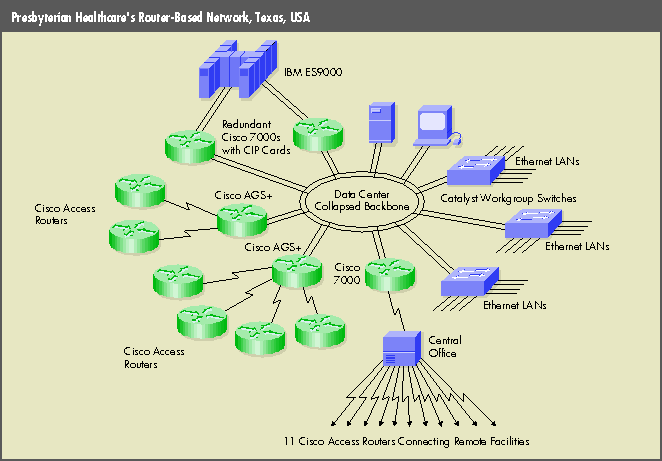
Since 1974, IBM's solution has been to perform these communications chores on a specialized device, such as the IBM 3745 Front End Processor (FEP) or 3172 Interconnect Controller. The 3745 handles Token Ring and Synchronous Data Link Control (SDLC) traffic over low-speed serial lines. The 3172 handles Fiber Distributed Data Interface (FDDI) traffic. But neither type supports T1, DS3, Asynchronous Transfer Mode (ATM), or other emerging standards.
After a recent installation of a new IBM ES-9000 mainframe, IS professionals at PHS were dismayed by what seemed to be their only option to connect the mainframe to their TCP/IP network: purchasing an expensive communications processor. But there was an alternative: Cisco's new Channel Interface Processor (CIP), a communications card that installs directly in the Cisco 7000 series routers.
"Cisco is helping reposition the mainframe for modern client/server networks," Lively says. "The CIP allows the mainframe to become a LAN- friendly, high-performance data server, rather than just a monolithic batch processor. It's a better solution, because it enables us to add the ES-9000 directly to the network."
Using one of IBM's traditional offload devices such as the 3172 would have meant directing network traffic first through the router, then through a Novell SNA gateway and 3172 cluster controller, and finally into the mainframe. With the CIP, network traffic goes straight from the router to the mainframe.
"All that stands between the mainframe and the router is a cable," Lively says. "This simplifies network maintenance and troubleshooting considerably. Fewer network links between user and host mean less chance of downtime."
A traditional front-end processor would have been at least twice as expensive as the Cisco solution, Lively adds. But manageability and reliability were even greater concerns. "With the CIP, you turn it on and it handles itself," he says. "IBM's 3172, on the other hand, is actually a PC running OS/2, which needs ongoing maintenance and configuration."
Today, Cisco's CIP cards are integral components in a network that links four major hospitals and a dozen clinics. There are 210 different applications available on 51 different computing platforms, allowing PHS to supply the newest and best medical applications to its users. Many of these applications are still mainframe-based, but others are LAN-based, which implies complex, multiplatform support.
"To serve the diverse needs of the medical and operational groups within PHS, we must be able to offer equivalent support for many different platforms," Lively says. "The very best laboratory system won't necessarily run on the same platform as the best radiology system. We want our users to be able to choose the applications that meet their needs, whether that means an application for a PC or a mainframe."
The PHS network is a collapsed fiber backbone with 37 Ethernet segments. All hosts are in the computer room, but users can access them locally through more than 2000 diskless PCs. Two Cisco AGS+ routers in the data center streamline the LAN-to-LAN connections; these will soon be upgraded to Cisco 7000 series routers and Catalyst[tm] switches.
"The routers form the links among all the various network segments," Lively says. "If you are on Network 1 and you want to access some information on a host in Network 3, it's just a quick jump through one of the routers."
"In health care today, the foremost issue is keeping costs down," Lively stresses. This motive made the Channel Interface Processor an attractive choice. "But we are also chartered with increasing service levels," he says. "With the CIP card, I can deliver LAN traffic to the mainframe via ATM, Fast Ethernet, DS3, ISDN, Frame Relay -- anything the Cisco 7000 supports."
Cutting costs is important, but one thing is priceless: maintaining the necessary speed and reliability for effective access to the mainframe, where patient records are stored. "Our network routinely carries extremely critical information," Lively stresses. "We cannot afford any downtime."
___________________________________________________________________________________________________________
By Debra Gotelli, Product Marketing Manager, Cisco Systems Workgroup Business Unit
Network managers increasingly find that high-performance computation platforms and mission-critical applications can easily overburden a 10- megabits-per-second (Mbps) network. While managers would like to increase user productivity with faster LAN technology, they would prefer to leverage their existing technology rather than investing in entirely new ones. Thus the industry has moved to specify a new generation of Ethernet running at 100 Mbps -- Fast Ethernet.
Several networking companies joined to form the Fast Ethernet Alliance in 1993 to draft the IEEE's 802.3u 100BaseT specification and accelerate the acceptance of Fast Ethernet. The specification was approved as a standard in June 1995. The Fast Ethernet Alliance's primary goal is to ensure a seamless migration from traditional Ethernet to Fast Ethernet, while maintaining the Ethernet transmission protocol Carrier Sense Multiple Access Collision Detection (CSMA/CD) and supporting the most popular cabling scheme used today -- 10BaseT. The alliance has ensured that no changes are required to the upper-layer protocols and software that run on users' workstations. For example, no changes to the Simple Network Management Protocol (SNMP) software or Management Information Bases (MIBs) are needed.
| Cisco's Fast Ethernet Contributions |
|---|
| As a voting member of the IEEE and through the Fast Ethernet Alliance membership of Kalpana[r] a company that Cisco acquired in December 1994, Cisco made substantial contributions to the development of the basic and optional features of the Fast Ethernet specification. For example, at the 100BaseTX physical layer, Cisco contributed the Multilevel Transmit (MLT-3) line encoding technology that allows 100-Mbps transmissions, such as Fast Ethernet and FDDI, to run over Category 5 unshielded twisted pair (UTP5). In addition, Cisco contributed to the specification for the Media Independent Interface (MII), which supports external transceivers at the physical layer and is equivalent to the Auxiliary Unit Interface (AUI) in 10BaseT. Cisco also contributed the specification for full-duplex operation, first to the 10-Mbps Ethernet standard and then to the 100-Mbps Fast Ethernet standard. |
Although Fast Ethernet maintains CSMA/CD, the Ethernet transmission protocol, it reduces the transmission time for each bit by a factor of 10. Thus, the Fast Ethernet packet speed increases tenfold, from 10 Mbps to 100 Mbps. Data can move between Ethernet and Fast Ethernet without requiring protocol translation or software changes, because Fast Ethernet maintains the 10BaseT error control functions as well as the frame format and length.
Other high-speed technologies, such as 100VG-AnyLAN and Asynchronous Transfer Mode (ATM), achieve data rates in excess of 100 Mbps by implementing different protocols that require translation when data moves to and from 10BaseT. Protocol translation requires changing the frame, which often incurs higher latencies when passing through layer 2 (data-link layer) LAN switches.
In many cases, organizations can upgrade to 100BaseT technology without replacing existing wiring. Options for 100BaseT media are the same as those for 10BaseT; they include shielded and unshielded twisted pair (STP and UTP) and fiber. The Media Independent Interface (MII) provides a single interface that can support external transceivers for any of the 100BaseT physical sublayers.
While the 100BaseTX and 100BaseT4 specifications maintain the same 100-meter limit from the wiring closet to the desktop as in 10BaseT, 100BaseFX can exceed the 100-meter limit because it uses fiber instead of UTP. However, 100BaseFX is used primarily between wiring closets and campus buildings to make better use of its support for longer cables. Although they are not part of the Fast Ethernet specification, multimode to single-mode converters can extend the maximum distance of a 100BaseFX fiber cable to 32 kilometers.
Distance Limitations for Fast Ethernet Media Options
| Physical Sublayer Option | Cable Specification | Length (Meters) |
|---|---|---|
| 100BaseTX | Category 5 UTP, 2 Pairs 150-Ohm STP, 2 Pairs |
100m Half or Full Duplex 100m Half or Full Duplex |
| 100BaseT4 | Categories 3, 4, and 5 UTP, 4 Pairs |
100m Half or Full Duplex |
| 100BaseFX | 62.5 or 125 Multimode Fiber, 2 Strands | 400m Half Duplex 2000m Full Duplex |
Fast Ethernet technology supports a number of options, including full duplex, Auto-Negotiation for hubs and adapters, and flow control.
Full-duplex technology delivers up to 200-Mbps bandwidth because it provides bidirectional communication -- meaning that 100 Mbps is available for transmission in each direction. Full duplex also increases the maximum distance supported for fiber cables between two Data Terminal Equipment (DTE) devices up to 2 km.
| Vendors That Support Full-Duplex 10BaseT |
|---|
| · Cabletron Systems · Cogent · Compaq Computer Corp. · Compex Digital Equipment Corp. · IBM · Interphase · Milan · Xircom |
Network administrators can implement full-duplex communication by disabling the collision detection and loopback functions, which are necessary to ensure smooth communication on half-duplex links. Only switches can offer full-duplex transmission to directly attached workstations or servers. Shared 100BaseT hubs must operate at half duplex to detect collisions among end stations. Users will see greater performance improvements when full- duplex 100BaseT is implemented on a backbone connection, rather than a client connection, because client/server applications primarily transmit read/write asymmetrical traffic.
Members of Cisco's Workgroup Business Unit pioneered the development of full-duplex features for 10BaseT switching technology and have brought them forward for 100BaseT switching. Full-duplex 10BaseT technology is readily available and deployed by customers today. Adapter, hub, and switch vendors -- including Cisco and others -- have thoroughly tested and verified the interoperability of their 10BaseT products.
The 100BaseT specification describes a process called Auto-Negotiation, which allows devices at each end of a network link to automatically exchange information about their capabilities and perform the configuration necessary to operate together at their maximum common level. For example, Auto- Negotiation can determine whether a 100-Mbps hub is connected to a 10-Mbps or 100-Mbps adapter and then adjust its mode of operation accordingly.
Auto-Negotiation is performed out-of-band, using another technique known as Fast Link Pulse (FLP) Burst to identify the physical-layer technology with the highest wire speed that can be used by both devices. Auto-Negotiation also provides a Parallel Detection function that allows devices to recognize 10BaseT half- and full-duplex, 100BaseTX half- and full-duplex, and 100BaseT4 physical layers, even if one of the connected devices does not offer Auto-Negotiation capabilities.
With the Fast Ethernet specification, all devices along a path can use flow control to reduce the amount of data they receive. Network administrators can implement flow control on a link-by-link or end-to-end basis.
Link-to-link flow control examines only an individual link between switches or stations. When the recipient of a transmission becomes busy, it sends a signal to the directly linked transmitter. If that transmitter is not the originator of the traffic, this signal must be replicated back through each link necessary to reach the originator. With end-to-end flow control, switches at each end of a link communicate to regulate the traffic from the originating end stations. Until communication is complete, packets must be stored or dropped, meaning that flow control does not eliminate the need for buffers. Full duplex can add capacity for flow-control mechanisms between switches without reducing throughput.
As is the case for all high-speed networking technologies, network managers should choose products that have sufficient buffer space to keep pace with the network. Large buffers implement congestion control by ensuring that data received from the network can be stored until the workstation can accept it.
In the first phase of implementing 100BaseT, LAN switching can coexist with hubs and routers. For example, switches can segment hubs and thus increase performance on shared-media LANs without changing a network's topology. To enhance client/server performance across the enterprise, servers can connect directly to Fast Ethernet interfaces, which aggregate traffic from numerous switched 10-Mbps Ethernet segments. These switched workgroups connect to the rest of the enterprise through Fast Ethernet routers. The network manager should choose a switching platform that offers at least two switched Fast Ethernet interfaces for connecting to a server and router. The switching platform should support low-cost copper (10BaseFL) in the wiring closet and long-distance fiber (100BaseFX) connections between closets and campus buildings.
In the second phase of Fast Ethernet implementation, network managers extend LAN switching to the desktop to provide dedicated bandwidth and virtual LAN (VLAN) services to the end stations. LAN switches can be linked together (or "cascaded") to build high-density networks. For use as a collapsed switch in the data center, a good switching platform should offer high-density Fast Ethernet and the ability to extend LANs over any Fast Ethernet interface. In addition, high-density Fast Ethernet is necessary for connecting multiple servers in the data center, as in "server farm" applications. Network managers can extend VLANs across the enterprise by connecting switches into routers with VLAN support. A switching platform that supports full duplex on all Ethernet and Fast Ethernet connections will improve performance.
In the third phase, shared Fast Ethernet bandwidth is integrated to the desktop, allowing user applications to obtain burst data speeds of 100 Mbps. When only a few users require this speed, the Fast Ethernet bandwidth can be shared with minimal contention.
In the final phase, Fast Ethernet switching is extended to the desktop to offer 100-Mbps server access to high-performance users of PCs and workstations. To complete this architecture for end-to-end high performance, the switching platform should also be capable of adding one or more ATM uplinks to a switched core of ATM switches. To scale upward for expansion across an enterprise, this phase of Fast Ethernet implementation lays a foundation for the CiscoFusion[tm] architecture, which incorporates the security and intelligence of routers as well as ATM and LAN switches. For more information on the CiscoFusion architecture, see Packet magazine, 2nd Quarter 1995 (Vol. 7 No. 2).
The final phase of designing with 100BaseT provides 10- and 100-Mbps shared bandwidth to the desktop, and 100-Mbps switching to workgroup servers, server farms, routers, and in the building backbone.
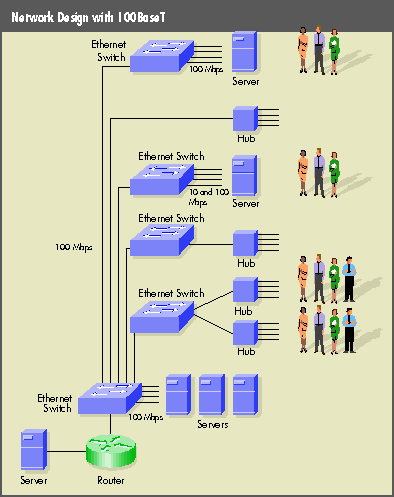
The Fast Ethernet standard is here at last and is supported on many computing and networking platforms. Network administrators can implement it in the backbone, the data center, and to all the way to the desktop. Today, Cisco Systems offers a complete line of Fast Ethernet products for users to take advantage of immediately, using the familiar Ethernet technology in which they've invested over the years.
___________________________________________________________________________________________________________
Compaq Platform to Integrate Cisco IOS[tm] Software
Compaq Computer Corporation and Cisco Systems have entered into an agreement that will result in the first products to incorporate internetworking technology into an industry-standard computing platform. The new networking products will offer a range of scalable solutions and promise to be simple to install, configure, and manage. "The experts in PCs and internetworking have agreed to help users maximize their investments in innovative technologies while reducing total ownership costs," says John Chambers, Cisco Systems President and CEO.
Compaq will integrate the Cisco Internetwork Operating System (Cisco IOS[tm]) software into a hardware platform that will display both the Compaq and Cisco IOS logos.
Small and medium-sized businesses and remote offices of large organizations will benefit most from products developed under the Cisco-Compaq agreement. The first products are scheduled to come to market in the first half of 1996. While Compaq will design and manufacture the new products, the agreement includes plans for cooperative testing, marketing, service, and support programs. The agreement, signed in June, also anticipates joint development of network management applications that build on Compaq technology and the CiscoWorks[tm] suite of network management applications. The marriage of Compaq's computing hardware technology and Cisco's networking software technology will ultimately generate components of more comprehensive integrated systems.
Compaq Computer Corporation, founded in 1982, is the world's largest supplier of personal computers. Compaq products, including desktop and portable PCs and servers, are available in over 100 countries.
___________________________________________________________________________________________________________
How Cisco Ensures Interoperability
The Cisco Internetwork Operating System (Cisco IOS[tm]) software -- the power at the core of Cisco Systems' networking products -- delivers a suite of networking capabilities, including security, routing intelligence, scalability, and interoperability across all common protocols. A growing number of Cisco's partners in the networking industry are integrating the Cisco IOS software into an expanding range of products, such as hubs, X.25 switches, and multiplexers.
Below is a partial list of Cisco IOS licensees authorized to use the Cisco IOS logo as a sign of reliability and interoperability.
Cisco IOS[tm] Partners
| Company | Products Integrating the Cisco IOS[tm] Software |
|---|---|
| Alcatel | X.25 and PBX switches |
| Cabletron Systems | MMAC and MMAC+ hubs |
| Chipcom Corp. | ONline and ONcore hubs |
| Compaq Computer Corp. | Internetworking products |
| Digital Equipment Corp. | Hub 90 |
| LanOptics | STACKNET stackable hub |
| NET | IDNX WAN bandwidth manager |
| Northern Telecom | DPN 100 Magellan access switch |
| Optical Data Systems | Infinity hub |
___________________________________________________________________________________________________________
| Company | Focus | Region | Alliance Objectives |
|---|---|---|---|
| AT&T | Network Management | USA | The CiscoWorks[tm] suite of network management applications is now available on AT&T's OneVision enterprise management platform. As announced in June 1995, CiscoWorks features for managing, planning, and reporting complement the AT&T OneVision strategy of delivering end-to-end, single-point control of enterprise internetworks to AT&T customers in the USA. |
| IBM | APPN Support | Global | Cisco's multiprotocol routers will support IBM's Advanced Peer-to-Peer Networking (APPN), beginning in the third quarter, 1995. The APPN implementation, based on code licensed from IBM, will enable Cisco routers to carry both SNA and native APPN traffic across networks using IBM protocols. The Cisco Internetwork Operating System (Cisco IOS[tm]) software will incorporate APPN support, allowing concurrent, native routing of SNA and IP or other protocols supported by Cisco routers. |
| IBM | Workgroup, LAN Switching | Global | In May 1995, IBM and Cisco Systems signed an agreement on technology transfer, joint product development, and product sales for workgroup LAN switching. |
| Metaplex | Software for IBM Internetworking Environments | Global | Cisco and Metaplex have agreed to jointly develop software-based connectivity solutions for IBM internetworking environments. The products will focus on LAN switching, access protocol technology, and mainframe connectivity. Metaplex brings considerable IBM SNA development expertise to the alliance, which was announced in July 1995. The Australian firm will help Cisco's business unit for IBM internetworking solutions accelerate the rate at which it brings new products to this rapidly growing market. |
| Teleport Communications Group | Enterprise ATM Switches | USA | Teleport Communications Group (TCG) announced in May 1995 that it has chosen Cisco's LightStream 2020 enterprise ATM switch for deployment in TCG's new ATM switched data services, providing customized ATM connections for businesses and major long-distance carriers across the USA. The LightStream[tm] 2020 product will provide central office switching, where high-bandwidth performance is crucial, as well as edge switching at the customer premises, where flexibility matters most. |
___________________________________________________________________________________________________________
Cisco Systems has formed five distinct business units, each headed by a vice president/general manager. The change prepares the company to address new and expanding markets.
___________________________________________________________________________________________________________
The need for rapid deployment of large, heterogeneous networks is driving an increase in the demand for highly qualified engineering support. To continue to meet this demand while maintaining the highest level of customer satisfaction, Cisco Systems has purchased a minority interest in International Network Services (INS), a networking services company with a focus on large-scale networks.
INS provides services nationwide from its 15 locations in the USA.
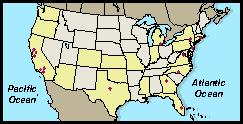
System engineers at INS pride themselves on their knowledge of Cisco products. INS has one of the largest numbers of Cisco Certified Internetwork Experts (CCIEs) outside of Cisco.
Dale Blagrove, an INS system engineer in the Western Region, typifies the high caliber of INS professionals. Blagrove's rigorous Cisco-specific training prepares him to act as a presales, postsales, and technical support engineer for Cisco's telecommunications group. "In addition to taking a week-long intensive router configuration class, I'm now training to become a CCIE," explains Blagrove. "As a member of the Cisco team, I have access to a wealth of resources which, combined with my experience in a wide variety of client settings, directly benefit customers."
INS System Engineer Dale Blagrove has worked on many Cisco-related networking projects and has a close working relationship with Cisco's Technical Assistance Center (TAC).
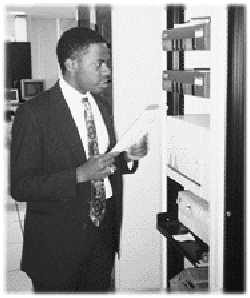
Bob Guimarin, a Cisco consulting engineer in Northern California who has worked closely with many INS system engineers, agrees with Blagrove about the benefits of the Cisco/INS tie. "Looking forward as new technologies arrive on the market," notes Guimarin, "partnerships like the one between INS and Cisco can help clients make choices to optimize their networks' cost-efficiency and functionality."
INS is notable for its focus on network operations while offering both consulting and technical services for mission-critical internetworks. Recognized for its expertise in innovative integrated solutions to multivendor network operations and management, INS provides ongoing custom contract services and remote electronic monitoring and management services.
Cisco customers are invited to put the combined internetworking experience and expertise of the Cisco/INS alliance to work for them in the design, implementation, operation, and optimization of complex networks. To learn how your organization can take advantage of the Cisco/INS collaboration, in the USA contact INS at 800 377-3INS.
___________________________________________________________________________________________________________
Cisco Systems will discontinue sales of the AGS+ router platform on November 1, 1995, in Europe and on December 1 in the rest of the world. Additionally, the company has announced that Cisco Internetwork Operating System (Cisco IOS[tm]) releases in the 9.X family (including 9.1, 9.14, and 9.17) reached their end-of-sales and end-of-maintenance milestones on May 1, 1995. The AGS+ platform end-of-sales does not apply to spare interface boards.
After more than five years as the industry's premier high-performance routing platform, the Cisco AGS+ will be discontinued at the end of 1995. The Cisco 7000 router family, newly expanded with the addition of the Cisco 7500 (see "New Cisco 7500 Delivers More Routing Muscle"), continues as the router of choice for today's most advanced internetworking applications.
Cisco will continue to support the AGS+ after its end of sales through the company's SMARTnet[tm] and Comprehensive Maintenance programs. Customers with either of these service contracts are entitled to free software updates through all maintenance releases of Cisco IOS Release 11.0, as well as 24-hour phone support through the Technical Assistance Center (TAC), and advance replacement hardware for repairs. Comprehensive Maintenance customers also receive onsite service. Customers who do not have maintenance contracts can purchase software updates and hardware repair services from Cisco to meet specific requirements.
Cisco recognizes the importance of protecting customers' investments. Customers often need the ability to add interfaces to their existing systems or to update their software to a later release. Subsequently, Cisco will continue to offer spare interface boards, appliques, plates, and cables. Software releases will be available for the AGS+ through Cisco IOS Release 11.0, and Cisco's Cisco Connection Documentation CD-ROM[tm] CD-ROM product will continue to provide documentation for all Cisco software releases.
As a regular part of a software release's life cycle, Cisco discontinues sales of that release for several reasons: to simplify the task of selecting and ordering software, to improve software support, and to help Cisco focus development resources on recent releases to continue delivering timely, high-quality software.
When a major Cisco IOS release reaches the end-of-sales point, it is no longer orderable through Customer Service or Manufacturing. Although such software can no longer be ordered in hardware or as spares, these releases are still available through sales representatives and the Cisco Connection Online (CCO) service for customers under maintenance contract.
When a major Cisco IOS release reaches end-of-maintenance, Cisco halts production of any further maintenance releases for it. Releases that reach this milestone continue to be available through the Field Sales organization and CCO for customers under maintenance contracts.
___________________________________________________________________________________________________________
How to Tap into Cisco's Networking Expertise
A wealth of Cisco news and networking information -- including Packet[tm] magazine -- is available to Cisco users online. Cisco Connection Online (CCO) brings you these services in addition to its hallmark, interactive customer support tools. Whether you're new to CCO or want to discover new features, Packet invites you to explore this sophisticated site on the Internet's World Wide Web.
World Wide Web URL:
http://www.cisco.com
White papers and technology briefs help you stay abreast of the latest technology. For example, to find out more about the advantages of ATM quality-of-service guarantees, refer to the online version of the ATM Internetworking white paper. Select Product Information, then Brochures.
CCO is constantly growing, with hundreds of documents added or updated each month. You're invited to log in and explore CCO's array of technical support resources and references tools.
___________________________________________________________________________________________________________
Fast Answers to Typical Problems
Cisco users can now get immediate answers to common internetworking problems, using Fax-on-Demand, a recent addition to Cisco's array of customer support tools. Users simply dial into a self-service fax server and enter their numbers to have technical documents sent immediately to their fax machines. Chosen by experienced Customer Service Engineers, available documents include configuration examples, cabling guides, and release notes.
Initially offered in the USA, the service is available through Cisco's Technical Assistance Center (TAC) at 800 553-2447 or directly at 415 598-4340. Fax-on-Demand servers will soon be available in other parts of the world, including Europe and Asia. In the meantime, Cisco Connection Online (CCO) carries these documents for registered CCO users. Documents can be downloaded by accessing CCO through the World Wide Web URL:
http://www.cisco.com
. From the CCO main menu, select Technical Assistance, then select Technical Tips & References, then Hot Tips.
___________________________________________________________________________________________________________
High-quality service and support are the hallmarks of Cisco Systems' certified channel partners. Gold- and Silver-Certified Partners have achieved Cisco-defined levels of sales and support excellence.
| Gold-Certified Partners | |||
|---|---|---|---|
| Company | Location | Company | Location |
| Alcatel BSG | Belgium | Geveke Electronics Network | The Netherlands |
| Alcatel Data Networks | UK | NIL | Slovenia |
| Alcatel MDS | Switzerland | Realtech Systems | USA |
| Alcatel Reseaux d'Entreprise | France | Siemens AG | Germany |
| Alcatel SEL | Germany | Siemens Albis | Switzerland |
| Bell Atlantic Network Integration | USA | Siemens Network Systems | UK |
| Bell Canada | Canada | Telemation GmbH | Germany |
| BT | UK | Unisys | Belgium |
| Chernikeeff Ltd. | UK | Unisys | France |
| Comtech | Belgium | Unisys | Germany |
| Consorcio Red Uno | Mexico | Unisys | Portugal |
| Cray Communications | New Zealand | Unisys | Switzerland |
| Datrac AG | Switzerland | Unisys | UK |
| Dimension Data | South Africa | Upnet AB | Sweden |
| Enterprise Networking Systems | USA | !nterprise Networking Services from US West | USA |
| Silver-Certified Partners | |||
| Company | Location | Company | Location |
| Arche Communications | France | RCS | France |
| Ascom TCS | Italy | SMS | Finland |
| BISS Ltd | UK | Telindus | Belgium |
| Interact Systemes | France | TRT/Experdata | France |
| ITS | France | Unisys | Belgium |
| ITS | UK | Unisys | France |
| NetCom | Israel | Unitronics | Spain |
| Open Systems | Austria | ||
Technical assistance Center (TAC) certification gives Cisco Systems' partners in Europe and South Africa direct access to Cisco's highest-level customer support analysts. TAC-certified partners team with Cisco's networking experts to offer prompt and effective solutions to Cisco Customers.
TAC certification is a prerequisite to achieving Gold-certified Partner status for Cisco's partners in Europe and South Africa.
| TAC-Certified Partners | |||
|---|---|---|---|
| Company | Location | Company | Location |
| Alcatel Business Systems | France | F. Hoffman La Roche | Switzerland |
| Alcatel MDS | Switzerland | Geveke Electronics Network | The Netherlands |
| Arche Communications | France | Netcom | Israel |
| Ascom TCS | Italy | NIL Ltd. | Slovenia |
| BISS Ltd. | UK | RCS | France |
| Chernikeeff Ltd. | UK | Santa Monica Software | Finland |
| ComTech | Belgium | Siemens AG | Germany |
| Convex Supercomputer | Portugal | Telemation GmbH | Germany |
| Datrac AG | Switzerland | Telindus | Belgium |
| Digital Equipment Company Ltd. | UK | Unisys | Belgium |
| Dimension Data | South Africa | Upnet AB | Sweden |
The following organizations are certified to present official Cisco training courses. Authorized training from Cisco-certified instructors helps users optimize their Cisco-based networks.
To learn more about Cisco Systems' Training Partner program, call the Training Partner information line at Cisco's California headquarters, 408 526-5444 or e-mail
tpartners@cisco.com.
| Training Partners | |||
|---|---|---|---|
| Company | Location | Company | Location |
| American Research Group | USA | ITS | France |
| Ascolta | USA | Managed Training Services Ltd. | UK |
| ASK Training Solutions Group | Australia | Multirede Information Ltd. | Brazil |
| AT&T Global Information Solutions | Germany | New Horizons | South Africa |
| AT&T Education | UK | NIL Limited | Slovenia |
| AT&T Global Information Solutions | USA | Pro-In Consulting | Austria |
| Automation Research Systems | USA | Protocol Interface, Inc. | USA |
| BISS Ltd. | UK | PSC Asia Pacific | Australia |
| CTT, Colombia | Colombia | PSC Group | Canada |
| Chesapeake Computer Consultants, Inc. | USA | PSC International | USA |
| ComTech | Belgium | PSC Europe | UK |
| CSK Corporation | Japan | PTT Telecom | The Netherlands |
| Cygnus-CTT | Venezuela | Red Uno | Mexico |
| DataCollege | New Zealand | Ronin | The Netherlands |
| Datrac AG | Switzerland | Siemens AG | Germany |
| Databrain-Geveke Electronics | The Netherlands | ST Computer Systems | Singapore |
| Dotcom Data and Telecommunications, A.B. | Sweden | SoftNet S.A. | Argentina |
| Horizon Open Systems | Republic of Ireland | Telinfo | Belgium |
| I-Cube | Philippines | Training & Consulting by Matthias Hagen | Germany |
| Information Management Systems | USA | Training Partners Pte. Ltd. | Singapore |
| Institut ERIS | France | Training Partners Pte. Ltd. | Hong Kong |
| Internetworking University | Norway | US West Communications | USA |
| Internetworking University | Sweden | ||
Cisco-Certified Training Partners offer a broad range of courses that enable you to develop the expertise to build and maintain a strategic, scalable corporate-wide internetwork. Whether you're a network planner, network technician, or network administrator, you'll find the course that's right for you.
The Cisco Training Broadcast brings you the latest information on course descriptions and outlines, worldwide training schedule, list of Cisco-Certified Training Partners, and registration instructions
To receive your copy, call the Cisco sales office nearest you, as listed in "Cisco Systems Worldwide Offices," or in the USA call 800 553-NETS (6387) or 408 526-7290.
___________________________________________________________________________________________________________
The Cisco seminar program provides free half-day and day-long seminars on a variety of enterprise networking solutions. Topics range from internetworking basics to emerging LAN and WAN technologies, such as ATM switching.
Hosted by Cisco Systems and Madge Networks, this seminar explains what Token Ring switching is, how it works, and how it can be the answer to protecting your investment in Token Ring technology by enhancing the bandwidth of your existing network infrastructure.
| October 10 | Chicago, Illinois, USA |
| October 11 | Minneapolis, Minnesota, USA |
| October 12 | Atlanta, Georgia, USA |
| October 17 | Los Angeles, California, USA |
| October 18 | San Francisco, California, USA |
| October 19 | Houston, Texas, USA |
Cisco Systems sponsors this seminar featuring Dr. John McQuillan, a leading authority on advanced networks. Dr. McQuillan will survey switched internetworking technologies and present a tutorial on using ATM to build scalable switched internetworks.
| September 18 | San Jose, California, USA |
| September 19 | Los Angeles, California, USA |
| September 20 | Dallas, Texas, USA |
Evaluate network management solutions and learn practical techniques for deploying management platforms as centralized, distributed, hierarchical, or peer-to-peer systems.
| October 24 | Hartford, Connecticut, USA |
| October 25 | Stamford, Connecticut, USA |
| October 26 | Rochester, New York, USA |
Focusing on IBM SNA environments, Cisco experts will explain how to reduce the cost of network ownership by integrating and managing separate SNA and multiprotocol networks.
| October 17 | Norfolk, Virginia, USA |
| October 17 | San Antonio, Texas, USA |
| October 18 | Newark, New Jersey, USA |
| October 18 | Dallas, Texas, USA |
This highly technical seminar emphasizes the role of ATM in switched internetworking. Cisco consulting engineers will cover advanced topics including ATM signaling, P-NNI ATM routing protocols, operating native-mode protocols over ATM, and virtual LANs (VLANs).
| September 19 | San Diego, California, USA |
| September 19 | Buffalo, New York, USA |
| September 20 | Anaheim, California, USA |
| September 20 | East Syracuse, New York, USA |
| September 21 | Woodland Hills, California, USA |
| September 26 | Boise, Idaho, USA |
| September 26 | Santa Barbara, California, USA |
| September 27 | Riverside, California, USA |
| September 28 | Long Beach, California, USA |
| October 4 | Bellevue, Washington, USA |
| October 5 | Tigard, Oregon, USA |
| October 10 | Tysons Corner, Virginia, USA |
| October 11 | Schaumburg, Illinois, USA |
| October 12 | Richmond, Virginia, USA |
| October 17 | Albuquerque, New Mexico, USA |
| October 18 | Salt Lake City, Utah, USA |
| October 19 | Phoenix, Arizona, USA |
| October 24 | Oklahoma City, Oklahoma, USA |
| October 25 | Tulsa, Oklahoma, USA |
| October 26 | Little Rock, Arkansas, USA |
This overview of switching solutions will include case studies of high- bandwidth applications. The seminar will also explore design challenges of higher-speed technologies, and the benefits of virtual LANs (VLANs).
| September 19 | Baton Rouge, Louisiana, USA |
| September 20 | New Orleans, Louisiana, USA |
| September 21 | Austin, Texas, USA |
| October 3 | Cincinnati, Ohio, USA |
| October 4 | Cleveland, Ohio, USA |
| October 5 | Columbus, Ohio, USA |
As networks continue to grow both in size and in number of remote locations, connectivity and ease of use become critical. Cisco experts will demonstrate how remote user sites can access resources that were once the exclusive realm of large, multiprotocol core networks.
| September 19 | Eatontown, New Jersey, USA |
| September 20 | Edison, New Jersey, USA |
| September 21 | Baltimore, Maryland, USA |
| September 26 | Sacramento, California, USA |
| September 27 | San Francisco, California, USA |
| September 28 | San Ramon, California, USA |
This seminar covers the fundamentals of internetworking technologies. Cisco experts will show you how to design, install, and manage cost-effective internetworks.
| September 20 | Cromwell, Connecticut, USA |
| September 28 | Binghamton, New York, USA |
| October 11 | Reno, Nevada, USA |
| October 12 | Las Vegas, Nevada, USA |
In the USA call 800 829-NETS (6387). For information on seminars offered in Canada call 800 668 0856. For information on seminars offered outside the USA and Canada, call the Cisco regional sales office nearest you, as listed on the back cover of this publication, or contact your local authorized Cisco partner/reseller.
Complete seminar listings are also available from Cisco Connection Online (CCO) at World Wide Web URL:
http://www.ciso.com.
___________________________________________________________________________________________________________
Groundbreaking ceremonies in May 1995 started a second wave of construction at Cisco Systems' two largest facilities in the USA -- the company's San Jose, California, headquarters and its new Research Triangle Park (RTP) facility in North Carolina.
During groundbreaking ceremonies at Cisco headquarters, President and CEO John Chambers speaks before a group of Cisco employees and local dignitaries.

At both locations, groundbreaking for second-phase construction took place within weeks of phase-one building openings. In San Jose, the last of eight buildings constituting the first phase of Cisco's headquarters site was preparing to open, while in North Carolina, ceremonies earlier in the month marked the opening of phase one of the RTP site.
The San Jose headquarters expansion, located across the street from the 811,000-square-foot site just completed, will comprise four buildings to add 553,000 square feet. "We're following an aggressive construction schedule that calls for completion of the first building in early 1996 and opening of the last building before the end of 1996," notes Nancy Bareilles, Cisco Director of Real Estate and Facilities.
Selby Wellman, Vice President and General Manager of Cisco's business unit for IBM internetworking solutions, delivers remarks at the groundbreaking for second-phase construction in Research Triangle Park, North Carolina.

The RTP expansion adds 120,000 square feet that will house up to 450 new employees. The facility is home to Cisco's newly formed business unit that focuses on mainframe internetworking. It also houses an inside sales operation and a customer support engineering group. In the future the facility will be the site for further expansion of Cisco operations on the East Coast.
___________________________________________________________________________________________________________
Responding to the growing need for advanced customer support tools, Cisco Europe recently implemented VideoLink, a videoconferencing support hotline, and PartnerLink, an advanced problem resolution applications suite for Cisco partners.
Using an ISDN line, VideoLink allows users to establish videoconferencing with Cisco experts in several European locations, including Paris, London, Brussels, Munich, Stockholm, and Zurich. "The advantages of videoconferencing are twofold: seeing the people you're speaking with promotes more effective communication, and seeing the hardware you're discussing facilitates instruction," says Rita Thijs, Director of Customer Advocacy for Cisco Europe.
Building on the concept of the "virtual" organization, PartnerLink provides Cisco partners with transparent access to Cisco's global call-tracking system. Thijs adds, "It is part of Cisco's culture to share information openly. By giving partners access to one of our core applications, we get closer to our customers, and that is what good customer service is all about."
For more information on VideoLink or PartnerLink:
___________________________________________________________________________________________________________
Cisco Systems is the first internetworking vendor to achieve global International Organization for Standardization (ISO) 9001 certification. The ISO 9001 standard is the most stringent of the 9000 series of international standards for quality management systems. Cisco has met or exceeded ISO 9001 quality control requirements since November 1993, when the company became the first major supplier of internetworking products to achieve ISO 9001 certification for its headquarters operations in the USA. Global certification applies to design, manufacture, and service functions at Cisco locations worldwide, and extends the benefits of uniform, comprehensive quality management controls to Cisco customers around the globe.
___________________________________________________________________________________________________________
The British Approvals Board for Telecommunications (BABT) has granted Cisco Systems its Full Quality Assurance (FQA) approval for the entire European Community. The BABT has approved the production, design, and testing procedures for Cisco products that connect to European public telecommunications networks. FQA approval, currently held by only four companies in the world, circumvents the need for lengthy homologation and will streamline the process for Cisco to deliver new products and enhancements to its European customers.
___________________________________________________________________________________________________________
Live ISDN connections will link showrooms at more than 100 locations around the world for Global `95, a three-day event designed to promote ISDN as a viable international communications infrastructure for building information superhighways. Open-house events November 28 through 30, 1995, will demonstrate a wide range of "real-world" ISDN applications for home users, entertainment, education, government, business, and health care.
Cisco Systems, an event sponsor, will feature ISDN multimedia and telecommuting applications at showrooms around the globe. Plans call for videoconferencing connections to run concurrently with Internet access, so that a Global `95 attendee in Paris, for example, might videoconference with a colleague in Hong Kong while viewing this article from the online version of Packet magazine from the same screen. Simultaneous video and data transfer applications are enabled by the prioritization and bandwidth reservation features of the Cisco Internetwork Operating System (Cisco IOS[tm]) software.
Cisco is among more than 100 event sponsors, including telecommunications providers and customer-premises equipment manufacturers from Europe, North America, Asia, South America, Africa, Australia, and the Middle East.
For more information on Global `95 events, in the USA contact Bellcore at 800 992-ISDN or in the UK contact Western Connect at 441504 370726. Information is also available online from the Global `95 Web site at the World Wide Web URL:
http://www.bellcore.com/GLOBAL95/home.html
.
___________________________________________________________________________________________________________
Covering Trends and Technology for Internetworking Professionals
Cisco World is the first independent news and technical publication to feature Cisco Systems and its partners.
To subscribe or to obtain more information:
In the USA, contact the publisher, Publications and Communications, Inc. (PCI, Texas, USA), at 800 678-9PCI (678-9724), ext. 5. Outside the USA, call 512 250-9023, ext. 5.
___________________________________________________________________________________________________________
Atlanta, Georgia
Exhibition: September 27-29, 1995
Conference: September 25-29, 1995
Visit Cisco Systems at Booths 1052, 2858, and 4566
___________________________________________________________________________________________________________
Cisco Systems Annual Latin American User Symposium
Offered at two venues:
For more information, contact Irma Michelson at 408 526-4866 (USA).
___________________________________________________________________________________________________________
| September 19-21 | TCA, San Diego, California, USA |
| September 26--29 | Comnet `95, Sao Paulo, Brazil |
| September 27--29 | NetWorld+Interop `95, Atlanta, Georgia, USA |
| September 27--October 1 | Netcom, Moscow, Russia |
| October 10-14 | China Computerworld Expo'95, Beijing, China |
| October 11-12 | NetCon `95, Toronto, Ontario, Canada |
| October 18-20 | Landaba, Johannesburg, South Africa |
| October 23-25 | Enterprise Management Summit, Dallas, Texas, USA |
| October 24-27 | InterConnect, Sao Paulo, Brazil |
| October 25-27 | NSBA, Atlanta, Georgia, USA |
| October 26-29 | COMDEX/Asia `95, Singapore |
| October 28-31 | Gitex, Dubai, United Arab Emirates |
| October 30-November 1 | ABUI, San Jose, California, USA |
| October 31-November 1 | Educom `95, Portland, Oregon, USA |
| November 13-14 | NetWorkers `95, Buenos Aires, Argentina |
| November 16-17 | NetWorkers `95, Sao Paulo, Brazil |
| November 28-30 | Global `95, Worldwide |
| November 28-30 | TMA, Brighton, UK |
| November 28-December 1 | Cause `95, New Orleans, Louisiana, USA |
| December 1-2 | Tel-Ed, Fort Lauderdale, Florida, USA |
___________________________________________________________________________________________________________
Cisco Systems has over 120 sales offices worldwide. Call the company's corporate headquarters (California, USA) at 408 526-4000 to contact your local account representative or, in North America, call 800 553-NETS (6387).
| Corporate Headquarters | |
|---|---|
| Cisco Systems, Inc. 170 West Tasman Drive San Jose, California 95134-1706 USA World Wide Web URL:
http://www.cisco.com
Tel: 408 526-4000 800 553-NETS (6387) Fax: 408 526-4100 |
|
| Europe | |
|---|---|
| European Headquarters Cisco Systems Europe s.a.r.l. Parc Evolic-Batiment L2 16 avenue du Quebec BP706 Villebon 91961 Courtaboeuf Cedex France Tel: 33 1 6918 61 00 Fax: 33 1 6928 83 26 |
|
| Austria, Cisco Systems Austria GmbH Vienna, Austria Tel: 43 1 71110 6233 Fax: 43 1 71110 6017 |
South Africa, Cisco Systems South Africa Sandton, South Africa Tel: 27 11 784 0414 Fax: 27 11 784 0519 |
| Belgium, Cisco Systems Bruxelles Brussels, Belgium Tel: 32 2 778 42 00 Fax: 32 2 778 43 00 |
Spain, Cisco Systems Spain Madrid, Spain Tel: 34 1 383 2178 Fax: 34 1 383 8008 |
| Denmark, Cisco Systems Copenhagen, Denmark Tel: 45 33 37 71 57 Fax: 45 33 37 71 53 |
Sweden, Cisco Systems AB Stockholm, Sweden Tel: 46 8 681 41 60 Fax: 46 8 19 04 24 |
| Germany, Cisco Systems GmbH Unterschleissheim, Germany Tel: 49 89 32 15070 Fax: 49 89 32 150710 |
Switzerland, Cisco Systems Switzerland Naenikon, Switzerland Tel: 41 1 905 20 50 Fax: 41 1 941 50 60 |
| Italy, Cisco Systems Italy Srl Milan, Italy Tel: 39 2 269 290 85 Fax: 39 2 269 290 06 |
United Arab Emirates, Cisco Systems (Middle East) Dubai, U.A.E. Tel: 971 4310 433 Fax: 971 4313 681 |
| The Netherlands, Cisco Systems Gorinchem, The Netherlands Tel: 31 18 30 22988 Fax: 31 18 30 22404 |
United Kingdom, Cisco Systems Ltd. Feltham, United Kingdom Tel: 44 1 81 818 1400 Fax: 44 1 81 893 2824 |
| Norway, Cisco Systems Oslo, Norway Tel: 47 22 83 06 31 Fax: 47 22 83 22 12 |
|
| Intercontinental and Latin America | |
|---|---|
| Intercontinental and Latin America Headquarters Cisco Systems, Inc. 170 West Tasman Drive San Jose, California 95134-1706 USA Tel: 408 526-7660 Fax: 408 526-4646 |
|
| Argentina, Cisco Systems Argentina Buenos Aires, Argentina Tel: 54 1 811 7526 Fax: 54 1 811 7495 |
Mexico, Cisco Systems de Mexico, S.A. de C.V. Mexico City, Mexico Tel: 525 328 7600 Fax: 525 328-7699 |
| Australia, Cisco Systems Australia Pty. Ltd. North Sydney, Australia Tel: 61 2 935 4100 Fax: 61 2 957 4077 |
New Zealand, Cisco Systems New Zealand Auckland, New Zealand Tel: 64 9 358 3776 Fax: 64 9 358 4442 |
| Brazil, Cisco Systems Do Brasil Sao Paulo, Brazil Tel: 55 11 822 6095 Fax: 55 11 822 6396 |
|
| Asia | |
|---|---|
| Japanese Headquarters Nihon Cisco Systems K.K. Seito Kaikan 4F 5, Sanbancho, Chiyoda-ku Tokyo 102, Japan Tel: 81 3 5211 2800 Fax: 81 3 5211 2810 |
|
| Cisco Systems (HK) Ltd Wanchai, Hong Kong Tel: 852 2583 9110 Fax: 852 2824 9528 |
Cisco Systems (HK) Ltd, Kuala Lumpur Office Kuala Lumpur, Malaysia Tel: 60 3 236 5147 Fax: 60 3 236 5146 |
| Cisco Systems (HK) Ltd, Beijing Office Beijing, P.R.C. Tel: 86 10 501 8888, x821 Fax: 86 10 501 4530 |
Cisco Systems (HK) Ltd, Singapore Office Singapore Tel: 65 320 8398 Fax: 65 320 8307 |
| Cisco Systems (HK) Ltd, New Delhi Liaison Office New Delhi, India Tel: 91 11 688 1234, x119 Fax: 91 11 611 7688 |
Cisco Systems (HK) Ltd, Taipei Office Taipei, Taiwan Tel: 886 2 577 4352 Fax: 886 2 577 0248 |
| Cisco Systems, Indonesia Jakarta, Indonesia Tel: 62 21 523 9132 Fax: 62 21 523 9191 |
Cisco Systems (HK) Ltd, Bangkok Office Bangkok, Thailand Tel: 66 2 231 8300 Fax: 66 2 231 8121 |
| Cisco Systems Korea Seoul, Korea Tel: 82 2 3453 0850 Fax: 82 2 3453 0851 |
|
| North America | |
|---|---|
| Canada Cisco Systems Canada Limited Toronto, Ontario, Canada Tel: 416 217-8000 Fax: 416 217-8099 |
|
| United States Central Operations Cleveland, Ohio Tel: 216 520-1720 Fax: 216 328-2102 |
Northern Operations Bloomington, Minnesota Tel: 612 851-8300 Fax: 612 851-8311 |
| Eastern Operations Berwyn, Pennsylvania Tel: 610 695-6000 Fax: 610 695-6006 |
Service Provider Operations (Telecommunications) San Ramon, California Tel: 510 855-4800 Fax: 510 855-4896 |
| Federal Operations Reston, Virginia Tel: 703 715-4000 Fax: 703 715-4004 |
Southwestern Operations Dallas, Texas Tel: 214 774-3300 Fax: 214 774-3333 |
| Northeastern Operations New York, New York Tel: 212 330-8500 Fax: 212 330-8505 |
Western Operations San Mateo, California Tel: 415 377 5600 Fax: 415 377 5699 |
___________________________________________________________________________________________________________
Packet[tm] magazine is published quarterly and distributed free of charge to users of Cisco Systems products.
Direct address corrections and other correspondence to
http://www.cisco.com
Editor-in-Chief, Joanna Holmes
Editor, Patrice Snell Steiner
Design and Production, Jeff Ehlers
Project Coordinator, Amanda Burr
Cisco Systems Corporate Communications
Special thanks to the following contributors: David Baum, Paulina Borsook, Matt Burns, Barbara Dallenbach, John Drew (International Network Services), Debra Gotelli, Anne McLeod Haynes, Mel Lively (Presbyterian Healthcare Systems), Frank Marshall, Jerele Neeld (Compaq Computer Corporation), Carolyn Schuk, Paula Tuerk, and Sue Whiteside.
|
|
Copyright 1988-1995 © Cisco Systems Inc.